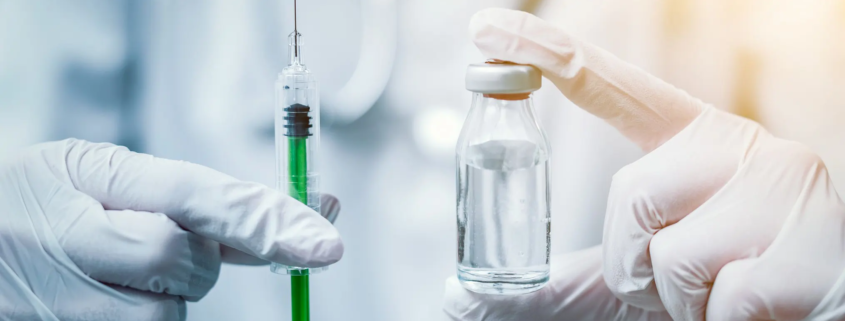A Break Through in Medical Injection Molding – Increase Throughput & Enhance Quality on Current Mold Machines by Applying an Innovative Approach to Core Pins
The COVID-19 pandemic has put pressure on numerous segments of the medical industry. Medical manufactures are working diligently producing consumables in unprecedented volumes with short lead times. Diagnostics companies are developing test kits that confirm the presence of the virus in hopes of slowing down the spread of infection. Research organizations worldwide are working on breakthrough solutions to cure the disease, like plasma therapy and vaccines. These industry manufactures, research organizations and diagnostic companies have one thing in common, they require disposable vehicles including vials, syringes, blood tubes, and specimen collection tubes to get the job done.
Most plastic medical consumables are manufactured using injection molding. The typical injecting molding process requires a mold, a molding machine, and plastic resin.
Injection Mold Design
Injection molds have multiple part cavities that consist of hollow spaces that replicate the shape of the medical component. A core pin creates the internal features of the part by filling the space. In addition to developing the part shape, the core pin has the important role of removing excess heat from the molded component. Through optimized cooling techniques cycle times are improved, which results in increased mold output. Core pins and cavities are designed larger than the actual part because the plastic component shrinks after it is manufactured in the mold. Low volume applications may require 4, 8, 16, or 32 cavities in a mold. Many high-volume medical applications such as syringes, blood tubes, pipettes, specimen collection tubes require high cavitations such as 96, 128, 192, or higher.
The Injection Molding Process
During the injection molding process molten plastic resin is inserted into a part cavity at high pressure (~ 10k-15k psi) often within a fraction of a second. This high-speed filing process forces the molten plastic into the cavity. The high-pressure injection force may deflect the core pin from its centerline position. This deflection can cause uneven filling of the cavity.
During the cooling cycle, cold water is run through the internal diameter of the core pin to remove excess heat from the cavity. Sufficient cooling ensures that the part can easily be stripped off the core pin. Once removed from the core pin the mold cycle is complete.
Core Pin Design
Core pins play an important role in the medical injection molding process. Their exacting design is critical to ensure proper function of the end product, for the patient and medical care providers’ safety. Over the year’s toolmakers have tightened tolerances and perfected the process of manufacturing stainless steel core pins. Most medical injection molds are equipped with hardened 420 stainless steel core pins, the industry standard for decades. As the medical world continues to evolve, improving patient safety requirements and requiring only the highest quality parts, manufacturers and toolmakers continue to tirelessly research the design and function of each and every component of every medical consumable.
SIDEBAR: Example of Tungsten Carbide Core Pins in Use

Potential Molding Issues
When molding long, small diameter, thin wall components a potential negative quality issue is non-uniform wall thickness. Non-uniform wall thickness results in a piece that should be immediately rejected. Consider a syringe, used for the delivery of medicine to the human body. The core pin forms the internal diameter of a syringe. A syringe plunger slides inside a syringe to draw and/or deliver fluid. The fit between the two components must be very accurate. A loose fit will spill the fluid and a tight fit prevents the syringe from functioning effortlessly. If the wall thickness of the syringe is not uniform it can result in leakage, or the desired volume of fluid can be altered.
Solutions to this problem differ, but they usually result in some type of compromise. One option is to redesign the syringe barrel increasing the wall thickness. This often leads to long development times, new mold tooling, and likely a reduction in valuable real estate within the mold. Another option is to slow down the speed of the injection molding process to allow a more uniform cooling and minimize deflection. This solution decreases the output of the molding machine and may require a substantial investment in molding machines to achieve the volumes required, especially during a pandemic.
Why Not Redesign the Core Pin?
Instead of accepting solutions with negative side effects Crafts Technology focused on the core pin design.
Approximately 15 years ago, Crafts engineering and manufacturing team developed an innovative solution to reduce part deflection and increase throughput, CraftAlloy™ CP Tungsten Carbide. By using a tungsten carbide design, you can achieve higher rigidity and uniform cooling characteristics (comparable to beryllium copper). Its high modulus of elasticity significantly reduces core shift/ deflection and allows for the highest possible precision and repeatability in an injection molding process.
CraftAlloy™ CP Tungsten Carbide Properties
| Properties | CraftAlloy™ CP Tungsten Carbide | 420 Stainless Steel | Percent Change |
| Young’s Modulus of Elasticity | 85000 kpsi | 30000 kpsi | 183% |
| Thermal Conductivity | 60 Btu/(ft-hr-F) | 14.4 Btu/(ft-hr-F) | 315% |
Crafts innovative solutions and craftsmanship have enabled medical consumable manufacturers to increase the production of quality COVID-19 test kits, vials, and test tubes at a rapid rate in record time.
Thanks to a culture of ownership combined with hard-working and dedicated suppliers, engineers, production, quality, and shipping teams Crafts has assisted many customers by manufacturing urgently needed tooling to fight the pandemic. Recently, the Crafts team completed the first set of test kit tooling in three weeks, a process that typically takes about 12 weeks.
By using CraftAlloy™ CP Tungsten Carbide core pins Crafts Technology successfully minimalizes deflection while maximizing heat transfer and wear life on existing injection molding processes, a technology that is advancing the medical industry around the world.





